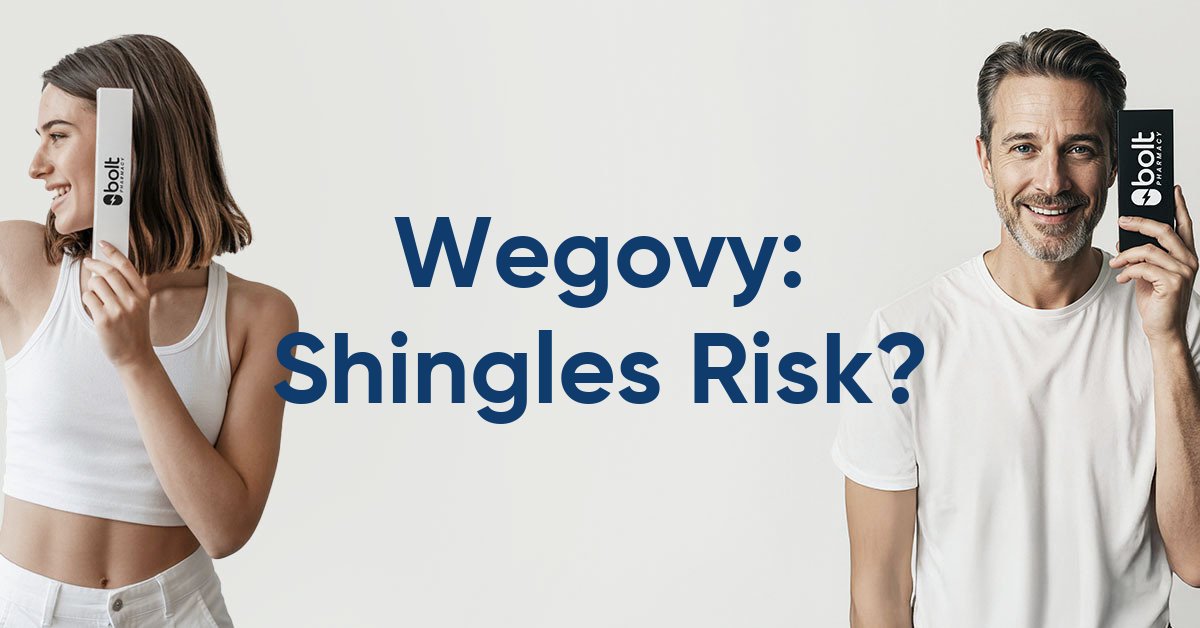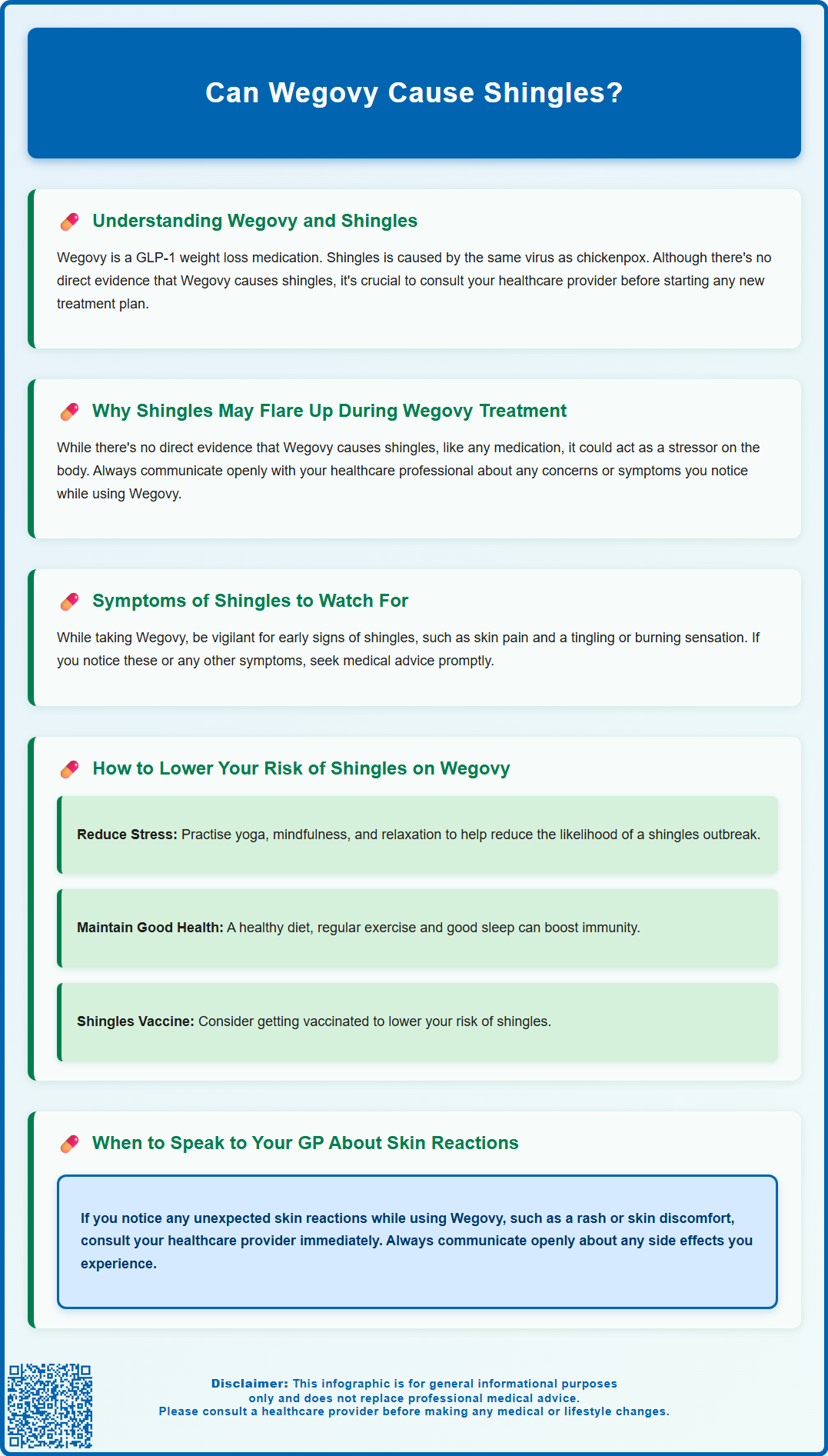Wegovy®
A weekly GLP-1 treatment proven to reduce hunger and support meaningful, long-term fat loss.
- ~16.9% average body weight loss
- Boosts metabolic & cardiovascular health
- Proven, long-established safety profile
- Weekly injection, easy to use

Are you exploring lasting weight loss solutions? An article on Bolt Pharmacy's blog examines the potential link between Wegovy, a GLP-1 medication for weight management, and the occurrence of shingles. This post offers valuable insights not only for those already using similar treatments, but also for those considering their options. Read on to understand any potential risk, helping you make a more informed decision about your metabolic health.
Summary: Wegovy is not known to cause shingles. Shingles occurs when the dormant varicella zoster virus (which causes chickenpox) is reactivated, usually due to age, stress, or a weakened immune system, rather than as a direct effect of Wegovy.
Wegovy (semaglutide 2.4 mg) is a prescription medicine licensed in the UK for weight management in adults with obesity (BMI ≥30 kg/m²) or those who are overweight (BMI ≥27 kg/m²) with weight-related health conditions. It belongs to a class of medications called glucagon-like peptide-1 (GLP-1) receptor agonists, which were originally developed for type 2 diabetes management but have proven highly effective for weight loss.
The mechanism of action centres on mimicking a naturally occurring hormone called GLP-1, which is released by the intestines after eating. Semaglutide works by:
Slowing gastric emptying, which helps you feel fuller for longer after meals
Reducing appetite by acting on areas of the brain that regulate hunger and food intake
Improving blood sugar control by stimulating insulin secretion when blood glucose levels are elevated
Decreasing glucagon secretion, which helps prevent the liver from releasing excess glucose
Wegovy is administered as a once-weekly subcutaneous injection, typically in the abdomen, thigh, or upper arm. The dose is gradually increased over 16-20 weeks to minimise gastrointestinal side effects. The standard titration schedule is 0.25 mg, 0.5 mg, 1.0 mg, 1.7 mg, and finally 2.4 mg at 4-weekly intervals. The maintenance dose is typically 2.4 mg weekly, though 1.7 mg may be used as an ongoing maintenance dose if 2.4 mg is not tolerated.
According to NICE guidance (TA875), Wegovy is recommended for NHS use only within specialist weight management services with multidisciplinary team support. It is available for adults with a body mass index (BMI) of at least 35 kg/m², or between 30-34.9 kg/m² with at least one weight-related comorbidity, alongside a reduced-calorie diet and increased physical activity. NICE says to consider stopping at 6 months if <5% loss, not an absolute requirement. Understanding how Wegovy works helps contextualise any potential effects on the immune system and overall health.
There is currently no established causal link between Wegovy (semaglutide) and an increased risk of developing shingles (herpes zoster). Shingles is not listed as a known or common adverse effect in the Summary of Product Characteristics (SmPC) approved by the Medicines and Healthcare products Regulatory Agency (MHRA), and there are no MHRA safety alerts linking semaglutide to shingles.
The pivotal clinical trials for Wegovy, including the STEP programme (Semaglutide Treatment Effect in People with obesity), involved thousands of participants followed for up to 68 weeks. Studies such as STEP 1, STEP 4, and STEP 5 published in the New England Journal of Medicine and JAMA did not identify shingles as a treatment-emergent adverse event occurring at higher rates in the semaglutide group compared to placebo.
GLP-1 receptor agonists do not directly suppress the immune system in the way that immunosuppressive medications (such as corticosteroids, chemotherapy agents, or biologics) do. The mechanism of action focuses on metabolic pathways rather than immune function. However, it's important to recognise that:
Weight loss itself may temporarily affect aspects of immune function, though evidence specifically linking this to viral reactivation is limited
Nutritional deficiencies during calorie restriction may impact overall health
Stress and lifestyle changes associated with weight management programmes can influence immune resilience
If you develop shingles whilst taking Wegovy, this is more likely to be coincidental rather than causally related to the medication. Shingles occurs when the varicella-zoster virus (which causes chickenpox) reactivates from dormant nerve cells, and this reactivation is influenced by numerous factors unrelated to GLP-1 receptor agonist therapy.
If you suspect any adverse reaction to Wegovy, you should report it through the MHRA Yellow Card scheme, which helps monitor the safety of medicines after they are licensed.

Shingles (herpes zoster) affects approximately 1 in 4 people during their lifetime in the UK, with incidence increasing significantly with age. Understanding the established risk factors helps contextualise why someone taking Wegovy might develop shingles, independent of their medication.
Primary risk factors for shingles include:
Age over 50 years – the most significant risk factor, as immune function naturally declines with ageing
Previous chickenpox infection – shingles can only occur in people who have had chickenpox, as the virus remains dormant in nerve tissue
Weakened immune system due to conditions such as HIV/AIDS, cancer, or autoimmune diseases
Immunosuppressive medications including high-dose corticosteroids, chemotherapy, or biological therapies
Physical or emotional stress, which can temporarily reduce immune surveillance
Recent illness or infection that diverts immune resources
Obesity is associated with chronic low-grade inflammation and altered immune function, though the specific relationship between obesity and shingles risk is not well established in the literature.
When undertaking significant weight loss with Wegovy, several factors warrant consideration:
Caloric restriction may temporarily affect immune cell production and function if nutritional intake is inadequate
Rapid metabolic changes during weight loss can be physiologically stressful
Improved metabolic health from weight loss may actually enhance immune function over time
The NHS offers shingles vaccination (Shingrix) to adults aged 65 years and those in the 70-79 age group as part of a catch-up programme. Shingrix is also available to those aged 50 and over who are immunosuppressed. This is a non-live vaccine given as a 2-dose course, usually 2-6 months apart. If you're taking Wegovy and fall into an eligible category, vaccination provides significant protection against shingles and should be discussed with your GP practice.
Early recognition of shingles is crucial because antiviral treatment is most effective when started within 72 hours of rash onset. Whether you're taking Wegovy or not, being aware of characteristic symptoms enables prompt medical attention.
Initial symptoms (prodromal phase) typically appear 1-5 days before the rash and may include:
Tingling, burning, or shooting pain in a specific area of skin, usually on one side of the body
Heightened skin sensitivity (hyperaesthesia) in the affected area
Headache, fatigue, or general malaise
Fever or chills in some cases
Itching or numbness in the area where the rash will appear
The characteristic rash develops in distinct stages:
Red patches appear on one side of the body, typically following a dermatomal distribution (the area supplied by a single nerve root)
Fluid-filled blisters (vesicles) develop within the red patches over 3-5 days
Blisters become cloudy, then crust over and scab within 7-10 days
Complete healing typically occurs within 2-4 weeks
Common locations include the torso (chest or abdomen), face (particularly around one eye), or neck, though shingles can affect any area supplied by sensory nerves. Shingles affecting the ear and facial nerve (Ramsay Hunt syndrome) can cause ear pain and facial weakness, requiring urgent assessment.
Important distinguishing features:
Shingles almost always affects only one side of the body (unilateral distribution)
The rash follows a band-like or stripe pattern corresponding to nerve pathways
Pain often precedes the visible rash, which can initially cause diagnostic confusion
If you develop these symptoms whilst taking Wegovy, do not discontinue your medication without medical advice. However, if you cannot maintain adequate fluid or food intake, or have significant gastrointestinal symptoms, contact your prescriber as temporary interruption may be advised. Document when symptoms began, as this timing is crucial for treatment decisions.
Prompt medical assessment is essential if you suspect shingles, as early antiviral treatment significantly reduces the severity and duration of symptoms and helps prevent complications. Whether you're taking Wegovy or any other medication, certain situations require urgent attention.
Contact your GP or NHS 111 within 72 hours if you develop:
A painful rash with blisters on one side of your body
Suspected shingles symptoms, particularly if you're over 50 or have a weakened immune system
Rash on your face, especially near the eye, as this requires urgent specialist assessment
Severe pain that interferes with daily activities or sleep
Seek same-day medical attention or attend A&E if:
Shingles affects the eye or surrounding area (ophthalmic shingles) – this can threaten vision and requires immediate ophthalmology review
You have a weakened immune system from any cause and develop suspected shingles
The rash becomes widespread or affects multiple body areas
You develop severe headache, neck stiffness, confusion, or sensitivity to light – potential signs of neurological complications
The affected area shows signs of bacterial infection (increasing redness, warmth, swelling, or pus)
You have ear pain and facial weakness (possible Ramsay Hunt syndrome)
Regarding your Wegovy treatment:
Continue taking Wegovy unless specifically advised otherwise by your healthcare provider
Inform your prescriber that you've developed shingles, particularly if you experience significant illness or reduced oral intake
Maintain adequate hydration and nutrition during shingles treatment, as this supports both recovery and the effectiveness of your weight management programme
Antiviral medications (such as aciclovir, valaciclovir, or famciclovir) are the mainstay of shingles treatment. While treatment is most effective within 72 hours, it may still be considered beyond this timeframe if new lesions are appearing, pain is severe, or in high-risk groups. No clinically significant interactions are expected between these antivirals and semaglutide, though you should check with a pharmacist or consult the BNF if you have concerns.
Keep the rash covered and avoid contact with pregnant people who have not had chickenpox, immunosuppressed individuals, and babies under 1 year until lesions have crusted over. Most people can continue their normal medications, including Wegovy, throughout shingles treatment and recovery. If you have concerns about any aspect of your treatment, your GP or specialist weight management service can provide personalised guidance.
There is no evidence that Wegovy (semaglutide) directly causes shingles. Shingles occurs when the dormant varicella zoster virus (which causes chickenpox) is reactivated. This reactivation can be triggered by factors such as age, stress, or a weakened immune system, but it is not a recognised effect of Wegovy. Always consult a healthcare professional if you are concerned about new symptoms while taking any medicine.
Shingles is not listed as a side effect of Wegovy. However, people who have previously had chickenpox carry the varicella zoster virus in their system, and it can reactivate later in life due to triggers such as stress or illness. If you are taking Wegovy and develop symptoms of shingles, seek medical advice promptly.
If you develop shingles while taking Wegovy, contact a healthcare professional immediately. Antiviral medicines are most effective when started within 72 hours of the rash appearing. Do not stop Wegovy without first discussing this with your healthcare professional.
The health-related content published on this site is based on credible scientific sources and is periodically reviewed to ensure accuracy and relevance. Although we aim to reflect the most current medical knowledge, the material is meant for general education and awareness only.
The information on this site is not a substitute for professional medical advice. For any health concerns, please speak with a qualified medical professional. By using this information, you acknowledge responsibility for any decisions made and understand we are not liable for any consequences that may result.
Lorem ipsum dolor sit amet, consectetur adipiscing elit, sed do eiusmod tempor incididunt ut labore et dolore magna aliqua. Ut enim ad minim veniam, quis nostrud exercitation ullamco laboris nisi ut aliquip ex ea commodo consequat. Duis aute irure dolor in reprehenderit in voluptate velit esse cillum dolore eu fugiat nulla pariatur.
Block quote
Ordered list
Unordered list
Bold text
Emphasis
Superscript
Subscript